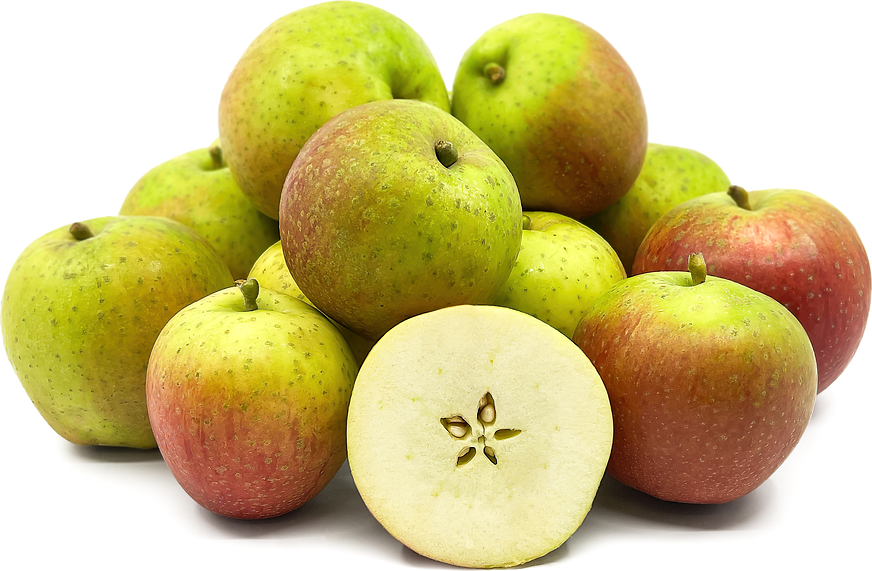


Mabbott's Pearmain Apples
Estimated Inventory, lb : 0
Description/Taste
Mabbott’s Pearmain apples are round, oblong, to conical fruits with a slightly flattened shape and a semi-thick, fibrous dark brown stem. The skin is rough, ripening from pale green to yellow, and is covered in red blush, prominent lenticels, and patches of russet. Underneath the surface, the flesh is coarse, aqueous, pale yellow to white, and dense, encasing a central core filled with small brown seeds. The flesh may also bear some light green veining. Mabbott’s Pearmain apples are aromatic and crunchy with a sweet, subtly tart, and fruity flavor.
Seasons/Availability
Mabbott's Pearmain apples are available in the fall through winter.
Current Facts
Mabbott's Pearmain apples, botanically classified as Malus domestica, are an old English variety that belongs to the Rosaceae family. The sweet-tart fruits date back to at least the 19th century and were a popular variety grown in orchards during the Victorian Era in England. In the modern-day, Mabbott’s Pearmain apples are scarce and are challenging to find outside of established trees in home gardens. The variety is considered a dessert cultivar, often consumed fresh, out-of-hand.
Nutritional Value
Mabbott’s Pearmain apples are a good source of vitamin C, which is an antioxidant that can help boost the immune system and rebuild collagen within the body. The apples also provide fiber to aid in digestion and contain potassium, phosphorus, and iron.
Applications
Mabbott’s Pearmain apples are best suited for raw applications as their soft flesh is showcased when consumed fresh. The apples can be eaten whole as a snack, sliced and served with sauces, dips, or nut butters, chopped and mixed into fruit and green salads, or diced and served as a fresh topping over baked goods, ice cream, and sweet desserts. They can also be blended into smoothies, pureed into a natural apple sauce, or spiced with cinnamon for added flavor. Mabbott’s Pearmain apples pair well with cheeses such as Monterey Jack, cheddar, and parmesan, arugula, spinach, nuts such as pecans, walnuts, and almonds, dried raisins, cranberries, balsamic vinaigrette, caramel, and dark chocolate. The fresh fruits will keep 1-2 months when stored in a cool, dry, and dark place.
Ethnic/Cultural Info
Pearmain is a descriptor used for multiple varieties of English apples that exhibit pear-like qualities, including extended storage capabilities, shape, and flavor. It is believed that there are over twenty-four varieties of apples that are labeled as pearmain, and many of these varieties such as Mabbott’s Pearmain are listed in the National Fruit Collection in England. Stored at Brogdale Farm near Kent and maintained by the University of Reading, the National Fruit Collection contains over 3,500 varieties of fruit in an effort to preserve diversity for future plant breeding. This collection is one of the largest collections in the world and is owned by Defra or the Department for Environment, Food, and Rural Affairs.
Geography/History
Mabbott’s Pearmain apples were first introduced commercially by farmer Lewis Killick in Maidstone, which is a town in Kent, England. While the first documentation of the variety occurred in 1883, experts believe the variety may be older and has been cultivated for many years before this date. After their release, Mabbott’s Pearmain apples became popular across England in the early 20th century, but over time the variety faded from mainstream markets due to an influx of new and improved cultivars. Mabbott’s Pearmain apples are considered very rare to find in markets in the current day and are primarily grown in home gardens in England.
Recipe Ideas
Recipes that include Mabbott's Pearmain Apples. One
| It's A Veg World After All |
|
Raw Rutabaga Salad with Apples |
| Forks Over Knives |
|
Apple-Lemon Breakfast Bowl |
| A Dash of Megnut |
|
Apple Guacamole |




